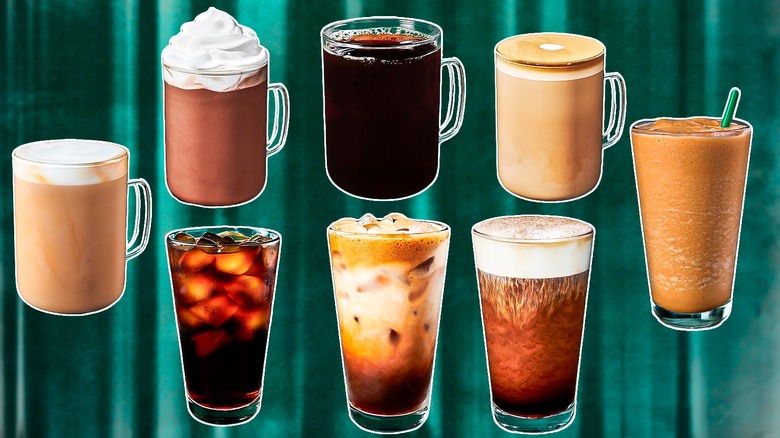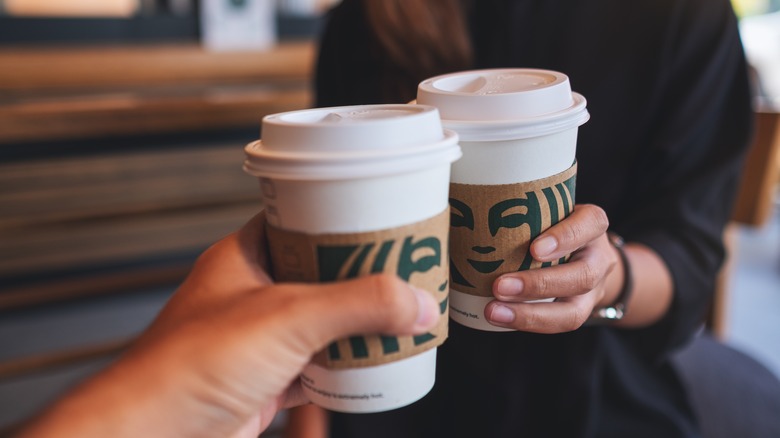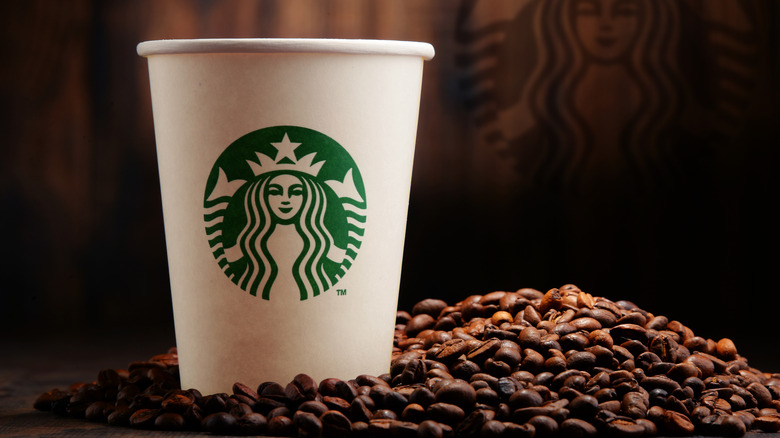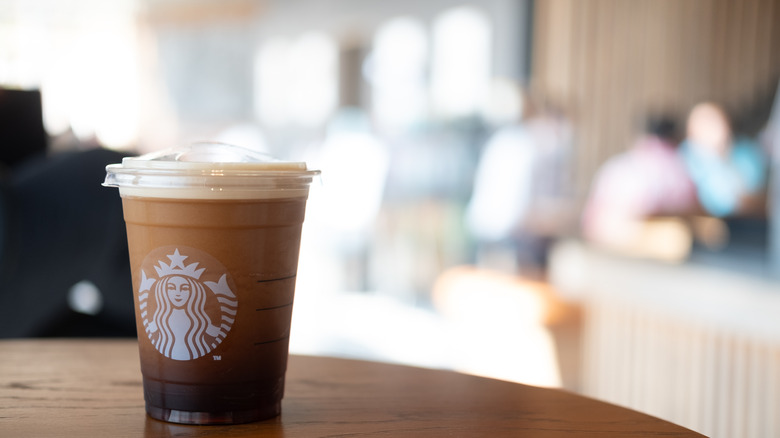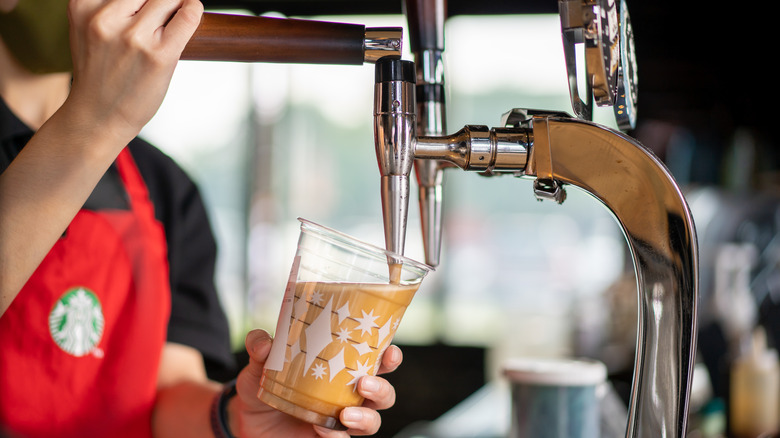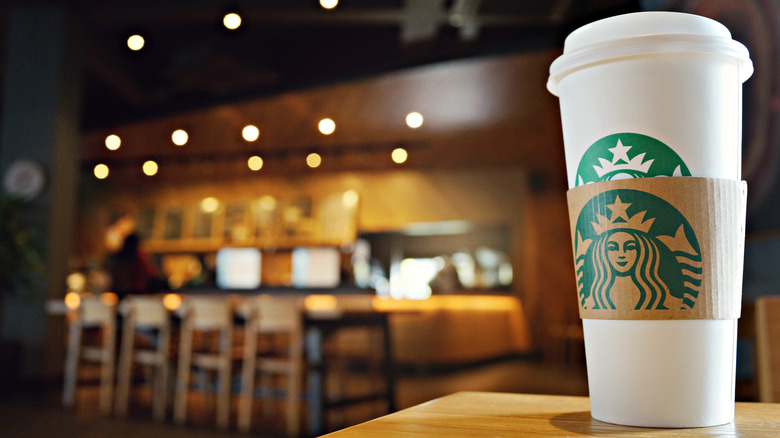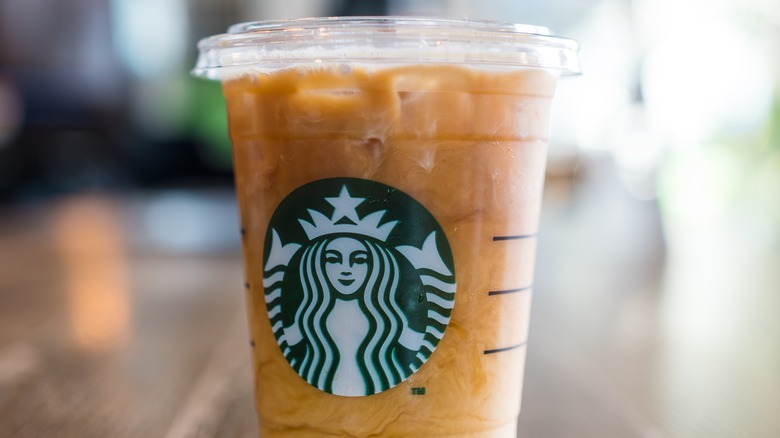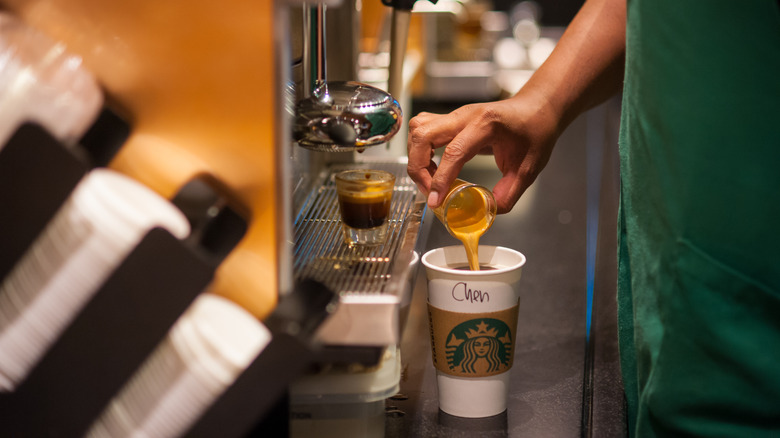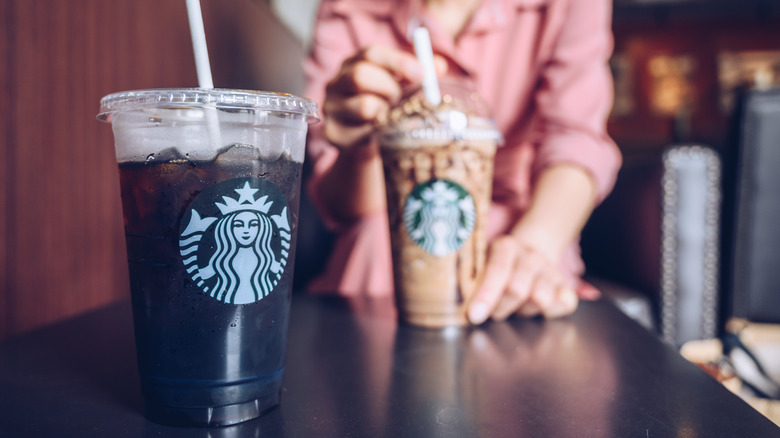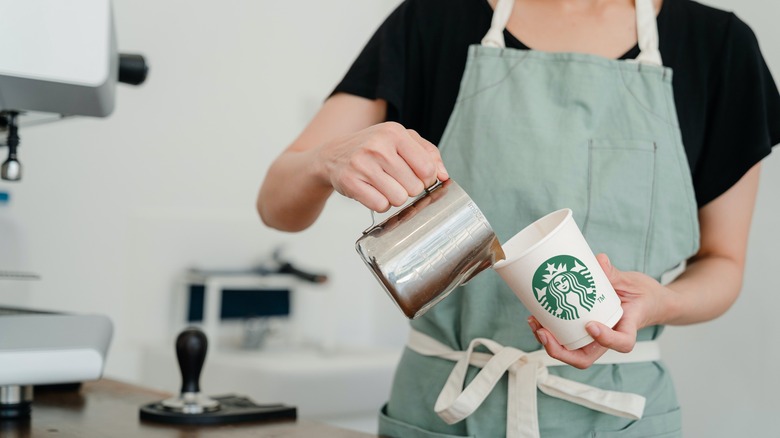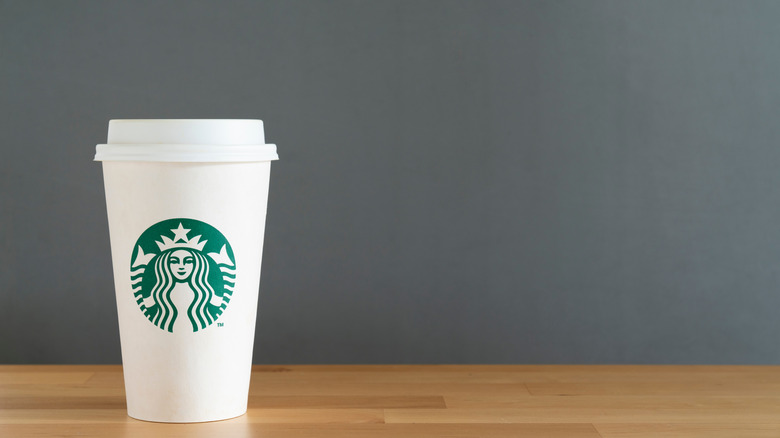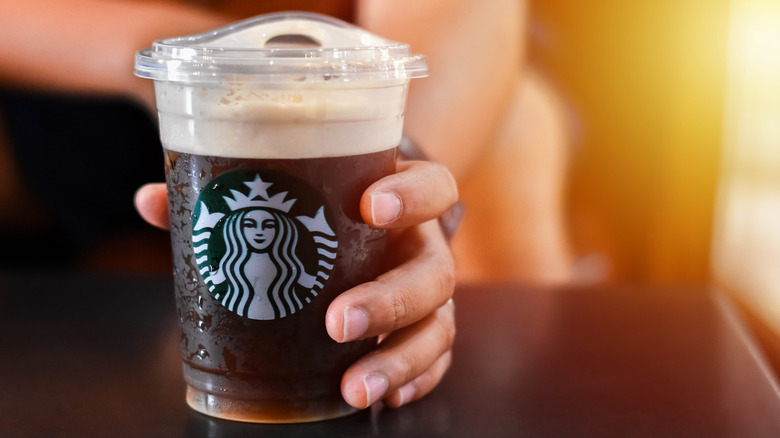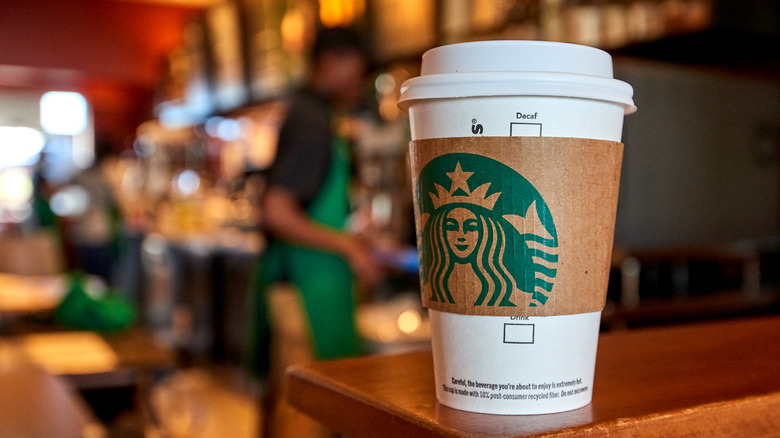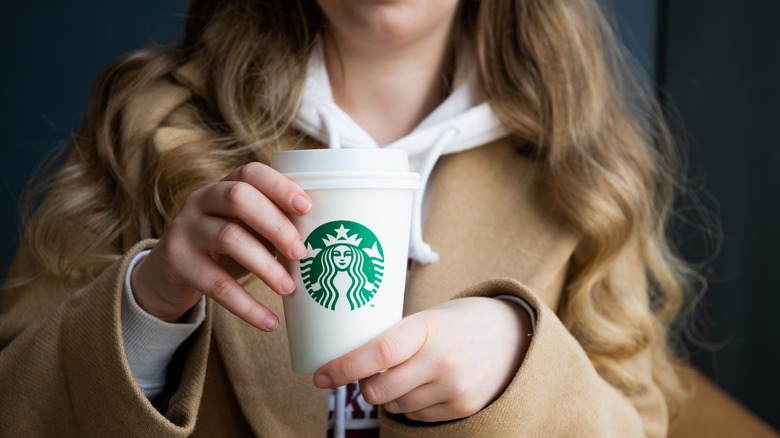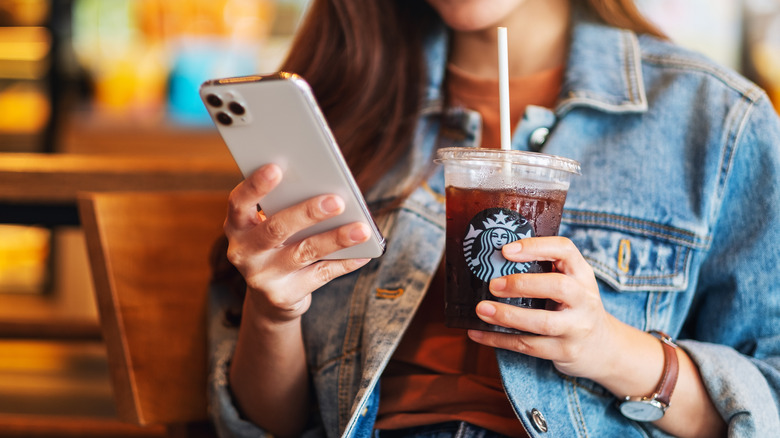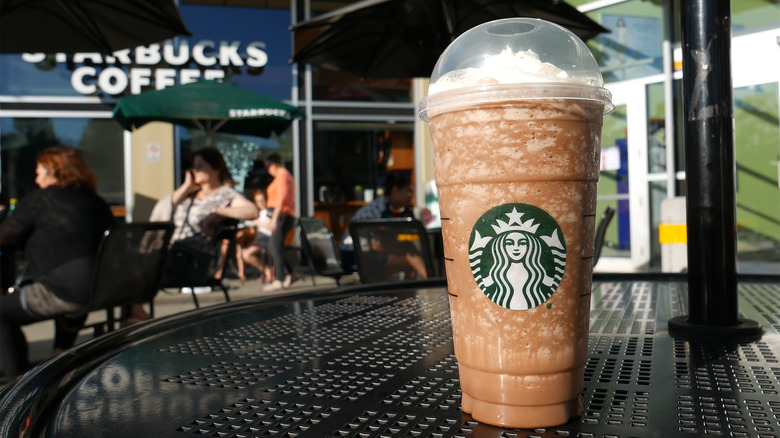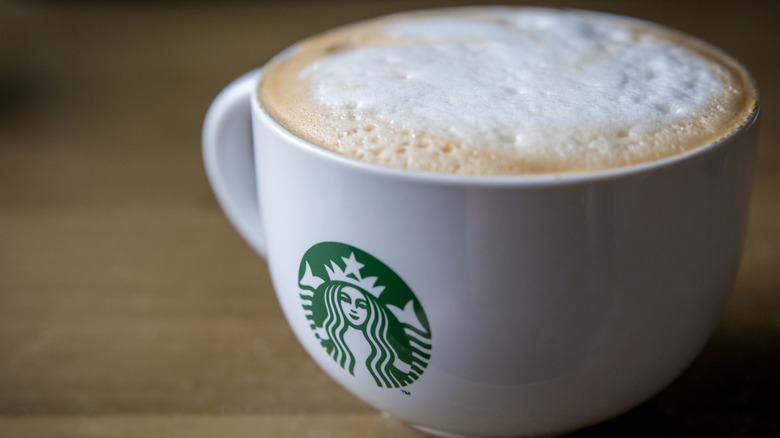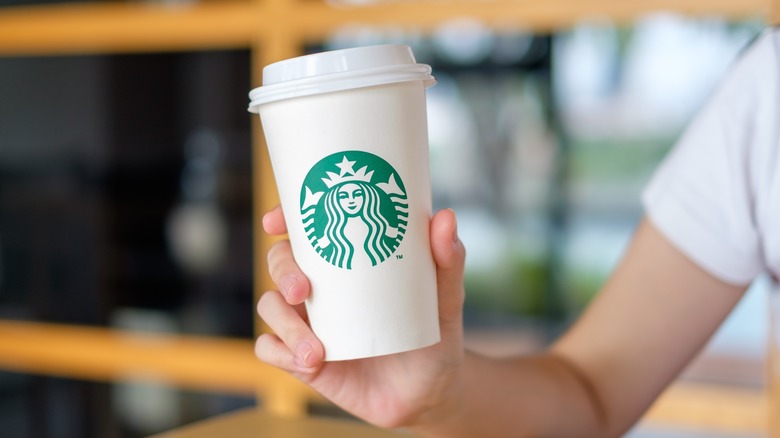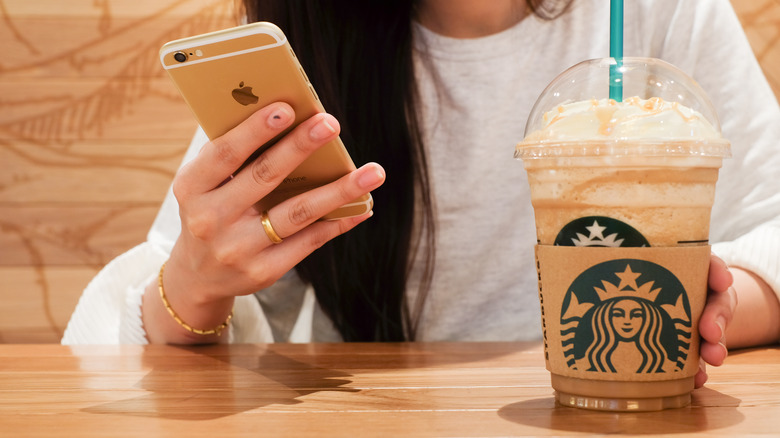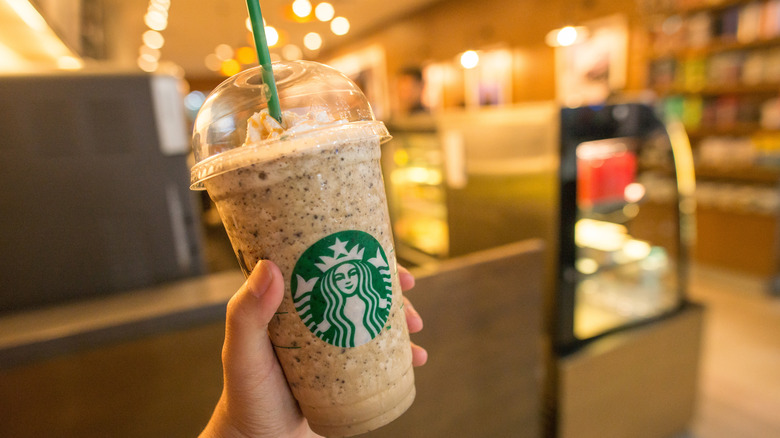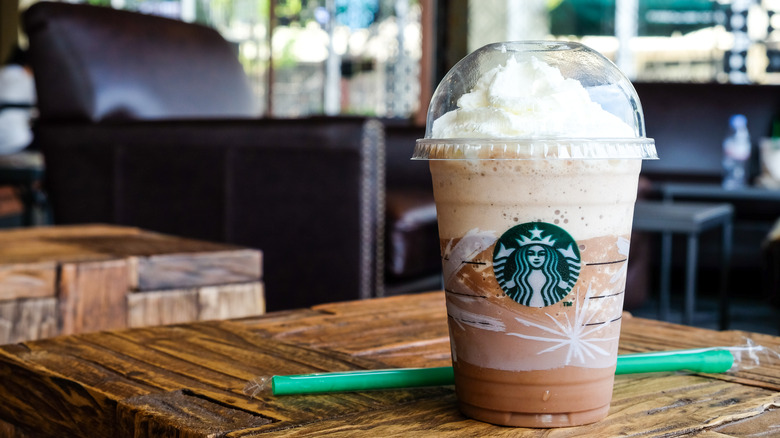The 20 Drinks At Starbucks With The Most Caffeine
If there's one word that's synonymous with Starbucks, it's caffeine. The international coffee powerhouse has been powering people across the country and around the world for more than 50 years.
But what is caffeine, and why do we crave it? According to Healthline, caffeine is a natural stimulant that blocks the neurotransmitter that relaxes our brains and ultimately causes feelings of fatigue. Caffeine can also get our blood pumping and increase the dopamine in our systems. Fortunately for night owls who sometimes need to be early birds, caffeine lives up to its promises quickly, with the caffeine from a cup of coffee taking about 20-60 minutes to kick in.
No matter what your caffeine needs, Starbucks has you covered — even if you prefer caffeine-free drinks. Each of the caffeine amounts listed below are for the 16-ounce version of the drink unless otherwise noted. Of course, you can usually scale up to a venti (20 ounces) or down to a tall (12 ounces) or short (8 ounces) as needed based on what you're fueling up for.
Blonde roast - 360 milligrams
Of all of Starbucks' brewed coffees, their Blonde Roast packs the biggest punch of caffeine. That's because the lower the roasting temperature, the more caffeine is retained during the roasting process.
Blonde roast, which has been a fixture on the Starbucks menu since 2012, is typically roasted to 350 to 375 degrees Fahrenheit, while darker roasts can climb to temperatures as high as 446 degrees Fahrenheit during the roasting process. If you're looking to Starbucks' blonde roast to get you out of an afternoon slump, note that you'll most likely be served a pour-over, as most locations only brew pots of blonde roast until noon.
Pike Place Roast - 310 milligrams
Starbucks' Pike Place Roast is the second runner-up for the highest caffeine count. Although this medium roast is named after Starbucks' first store in Pike Place Market in Seattle, which opened in 1971, it has only been on the Starbucks menu since 2008.
While light roasts like Starbucks' blonde roast are roasted until the first crack, medium roasts are roasted right up until the second crack, somewhere between 410 and 440 degrees Fahrenheit. The longer cooking time at a higher temperature is what makes a medium roast less caffeinated than a light roast, but Pike Place can still put plenty of pep in your step — especially since you can buy and brew it in the comfort of your own home.
Nitro cold brew - 280 milligrams
Because it's made with more coffee grounds than regular cold brew, nitro cold brew has more caffeine than any other cold beverage on Starbucks' menu. This nitrogen-infused pick-me-up was gradually added to menus at Starbucks stores from 2016 to 2019. Since then, it has contributed to the whopping 75% of the chain's beverage sales made up of cold drinks in mid-summer and early fall 2022, per The New York Times.
Fortunately for those who enjoy this smoother, sweeter take on cold brew, Starbucks also offers its nitro cold brew in a can. One 9.6-ounce can has 155 milligrams of caffeine, making it the perfect compromise for the nitro cold brew fan wanting to cut down on their caffeine consumption.
Cinnamon Caramel Cream Nitro Cold Brew and Vanilla Sweet Cream Nitro Cold Brew - 265 milligrams
Since nitro cold brew is the base for these creamy creations, they both offer a significant serving of caffeine. However, the addition of cream (and, in the case of the Cinnamon Caramel Cream Nitro Cold Brew, syrup) means that these drinks have less nitro cold brew and, therefore, less caffeine.
The Vanilla Sweet Cream Nitro Cold Brew also comes in a can, offering 9.6 ounces with 110 milligrams of caffeine. Although there isn't a can equivalent to the Cinnamon Caramel Cream Nitro Cold Brew, Starbucks does sell a 9.6-ounce can of Dark Caramel Nitro Cold Brew with 155 milligrams of caffeine.
Dark roast - 260 milligrams
It's a common misconception that dark roast has more caffeine than other brews, likely because of its bold taste. In fact, dark roast has less caffeine than its light and medium roast counterparts because the longer coffee beans are roasted, the less caffeine is preserved in the final product.
While some studies suggest that the difference in caffeine content between light and dark roasts is negligible, per Healthline, in Starbucks' case, their Featured Dark Roast has 100 fewer milligrams of caffeine than their Featured Blonde Roast. That said, if you prefer a dark roast and need an extra boost to get your day going, Starbucks sells dark roast K-Cup pods with added coffee extracts for twice the caffeine.
Iced Brown Sugar Oatmilk Shaken Espresso and Iced Hazelnut Oatmilk Shaken Espresso - 255 milligrams
While Starbucks launched its Iced Brown Sugar Oatmilk Shaken Espresso in spring 2021, its Iced Hazelnut Oatmilk Shaken Espresso just debuted at the start of 2024. Both of these plant-based beverages are brewed with Starbucks' blonde espresso, which is what gives them an extra jolt of caffeine.
For a less caffeinated option, you can always make your own iced shaken espresso at home using the espresso of your choice. Just keep in mind how that swap will affect the taste, as darker roasts with less caffeine also come with bolder flavors.
Caffè Americano - 225 milligrams
Starbucks' Caffè Americano is a simple yet satisfying combination of brewed water and espresso that can be served hot or iced. Ordered as-is, a grande Americano at Starbucks has three shots of their signature espresso roast, which gives the beverage the bold flavor it's known for.
However, you can customize the caffeine in your Americano by changing the number of shots or changing the espresso roast. There's Starbucks' blonde espresso, which is the base of some of their sweeter drinks, and there's a decaf option. To take your caffeine customization a step further, you can even order ⅓, ½, or ⅔ decaf.
Cold brew - 205 milligrams
Cold brew is exactly what it sounds like: Coffee that has been brewed (well, steeped, to be exact) in cold water instead of hot water. And with Food & Beverage Insider reporting that the popularity of cold brews has risen a staggering 300% since 2016, it's no wonder Starbucks currently has nine cold brews on their menu, plus several seasonal cold brews available for a limited time throughout the year.
Where caffeine is concerned, the cold brew at Starbucks is less caffeinated than some of their competitors' cold brews. A regular-sized cold brew at Dutch Bros has 240 milligrams of caffeine, while Dunkin's medium cold brew has 260 milligrams of caffeine.
Flat white - 195 milligrams
The flat white, which originated in either Australia or New Zealand in the 1980s, is made with ristretto espresso shots. Italian for "restricted," a ristretto shot, also known as a short shot, is the first portion of a full shot of espresso. This technique results in about an ½ ounce shot, whereas a full shot is about 1 ounce, so a ristretto shot is naturally less caffeinated than a full shot of espresso. But, since Starbucks' flat white recipe calls for three ristretto shots, you can be sure that a grande will energize you for the day ahead.
Starbucks Reserve brewed coffees - 195 milligrams
Starbucks' Reserve line offers a range of rare coffees from around the world that are available in Starbucks Reserve stores like the one in the Empire State Building. Some of their selections, however, are more widely available in local Starbucks stores, including those from Ethiopia, Guatemala, Malawi, and Vietnam, and each of these brews has 195 milligrams of caffeine.
Which of these brews you jump-start your day with depends on what flavor profile you're in the mood for. The Ethiopian blend has hints of lavender and lemon. The Guatemalan option has notes of candied orange, dark chocolate, and graham crackers. The brew from Malawi has cedar, citrus, and ginger flavors. And the Vietnamese grounds deliver the taste of cocoa peel and toffee nut.
Chocolate, cinnamon caramel, salted caramel, and vanilla sweet cream cold brews - 185 milligrams
Of the nine cold brews currently on the menu at Starbucks, four of them are packed with 185 milligrams of caffeine each: Chocolate Cream Cold Brew, Cinnamon Caramel Cream Cold Brew, Salted Caramel Cream Cold Brew, and Vanilla Sweet Cream Cold Brew. The most established of these is the vanilla version, which was introduced in 2016, and the coffee giant's latest introduction is the salted caramel flavor, which debuted in 2022.
Like many of Starbucks' other in-store options, Vanilla Sweet Cream Cold Brew and Salted Caramel Cream Cold Brew are available in 40-ounce bottles at major retailers like Target, and a 12-ounce serving of each brew has 150 milligrams of caffeine. Although Starbucks doesn't sell bottles of the chocolate or cinnamon caramel varieties, they do have a Dark Chocolate Oatmilk Cold Brew, which also has 150 milligrams of caffeine in a 12-ounce serving.
Caffè mocha - 175 milligrams
Part of the 175 milligrams of caffeine in Starbucks' caffè mocha comes from the cocoa in the mocha sauce. Per the U.S. Department of Agriculture, one tablespoon of cocoa contains about 12 milligrams of caffeine. However, one tablespoon of cocoa processed with alkali, like the cocoa in the mocha sauce in Starbucks' caffè mocha, as well as its hot chocolate, has about four milligrams of caffeine. Also known as Dutch-process, this type of natural cocoa is treated with an alkalizing agent to make it less acidic, resulting in a darker, smoother-tasting cocoa.
Blonde Vanilla Latte - 170 milligrams
What's the difference between a Blonde Vanilla Latte and a regular vanilla latte? The espresso. Available hot or iced, the standard recipe for Starbucks' Blonde Vanilla Latte calls for two shots of their blonde espresso, which was introduced in 2018 and has the highest concentration of caffeine of all of Starbucks' espresso roasts. By comparison, a regular vanilla latte with two shots of Starbucks' signature espresso roast has 150 milligrams of caffeine.
While they're not available year-round, two of Starbucks' holiday drinks are also made with blonde espresso and also have 170 milligrams of caffeine in a 16-ounce serving: the Gingerbread Latte and the Sugar Cookie Almondmilk Latte. Speaking of which, did you know that there are holiday drinks you can order year-round from Starbucks' secret menu? (You can thank us later.)
Iced coffee - 165 milligrams
According to American Dining Creations, historians believe that iced coffee was first developed in Algeria in 1840 when French soldiers added water to their coffee when they ran out of milk and drank it cold to offset the hot weather. Nowadays, it's hard to imagine a world without the infinitely customizable iced coffee, but it's only been on the Starbucks menu since 2006.
The caffeine content of iced coffee varies widely among national retailers, and Starbucks falls somewhere in the middle. Sixteen-ounce iced coffees at Dunkin', The Coffee Bean & Tea Leaf, Caribou Coffee, and Tim Hortons are more caffeinated than Starbucks'.
Espresso Frappuccino - 155 milligrams
Believe it or not, Starbucks' iconic Frappuccino will celebrate its 30th anniversary in 2025. This revolutionary blended beverage was the chain's entrée into cold drinks, expanding their fan base, as well as their seasonality. What started as just two flavors, coffee and mocha, has since expanded to nine year-round flavors, plus six-holiday flavors during the 2023-2024 season.
As you might expect, of all their Frappuccinos, Starbucks' Espresso Frappuccino has the most caffeine, but this drink might not have as much espresso as you expect. To make an Espresso Frappuccino, one shot of espresso and whole milk (or your milk of choice) are combined with three pumps of Starbucks' proprietary Frap Roast, a powdered mix specifically designed to replace hot coffee in Frappuccinos.
Cappuccino - 150 milligrams
In 2020, the National Coffee Association reported that consumption of espresso-based drinks like cappuccinos was up by 50% from 2015 to 2020, thanks in part to coffee drinkers in the 25-39 age group. A combination of equal parts frothed milk, steamed milk, and espresso, Starbucks' cappuccino calls for two shots of Starbucks' signature espresso roast.
Of course, this classic coffee, which has been on the menu at Starbucks since 1986, can be customized to your personal caffeine needs. For those who prefer a stronger cuppa — and maybe room for an extra helping of caffeine — but still want the familiar foam of a cappuccino, a bone-dry cappuccino, which doesn't include milk, might be just the ticket.
Cinnamon Dolce Latte - 150 milligrams
The Cinnamon Dolce Latte quickly became a fan favorite when it launched as a limited-time holiday drink in 2006 and is one of the best value drinks to order at Starbucks. Available hot or iced, Cinnamon Dolce Lattes are one of several drinks on Starbucks' menu with 150 milligrams of caffeine, as they are made with two shots of Starbucks' signature espresso and topped with four pumps of cinnamon dolce syrup and cinnamon dolce sprinkles.
Likely because of its popularity and staying power, Starbucks offers several cinnamon dolce-inspired products for fans to use at home, including ground coffee, K-Cup pods, and creamer. Both the ground coffee and the K-Cup pods are flavored blonde roasts, which makes them more caffeinated than the in-store version.
Caramel macchiato - 150 milligrams
What's in a name? Well, in the macchiato's case, it's Italian for a dash, mark, spot, or stain. Essentially, this beverage is made by adding a dash of milk to two shots of espresso.
Naturally, Starbucks' Caramel Macchiato, which has been on the menu for more than 25 years, is a classic macchiato enrobed in vanilla syrup and caramel drizzle. Available hot or iced in-store, you'll likely also find Starbucks Caramel Macchiato in the refrigerated section of your local grocery store. Forty-ounce bottles of pre-made caramel macchiato are sold at major retailers like Walmart, and a 12-ounce serving packs 125 milligrams of caffeine.
Java Chip Frappuccino - 105 milligrams
The Java Chip Frappuccino packs a one-two punch of caffeine. First, there are the three pumps of Frap Roast, a proprietary instant coffee-esque ingredient found only in Frappuccinos. Then, there's the three pumps of mocha sauce, which contains cocoa processed with alkali and yields about four milligrams of caffeine per tablespoon. Oh, and did we mention the Frappuccino Chips and mocha drizzle perched on top of a pillowy pile of whipped cream? With this much cocoa, which is naturally caffeinated, it's a wonder this decadent delight isn't higher on the list.
Mocha Frappuccino - 100 milligrams
Ingredient wise, Starbucks' Mocha Frappuccino is almost identical to its Java Chip Frappuccino: whole milk, three pumps of Frap Roast, three pumps of mocha sauce, and whipped cream. There are just two tiny differences, which ultimately result in a mere 5 milligrams difference in caffeine: The Java Chip version has Frappuccino Chips and mocha drizzle, and the mocha variety doesn't.
There's one thing the mocha has going for it that the Java Chip doesn't: A bottled version you can buy in stores nationwide. Starbucks first bottled its Frappuccino formula for grocery stores in 1996, and they're still widely available today, nearly 30 years later. In addition to the bottled Mocha Frappuccino, Starbucks offers bottled caramel, coffee, vanilla, and white chocolate mocha flavors. Not only are these glass bottles great for on-the-go, but they also offer a bit of flexibility in the caffeine department: the 13.7-ounce bottle has 105 milligrams of caffeine, while the 9.5-ounce option only has 70.
